Growing mungbeans successfully
Author: Kerry McKenzie (1), RCN Rachaputi (2), Bec Raymond (3), Nikki Seymour (4) | Date: 21 Jun 2016
1 Department of Agriculture and Fisheries, Tor St Toowoomba
2 QAAFI, Kingaroy
3 Department of Agriculture and Fisheries, Goondiwindi
4 Department of Agriculture and Fisheries, Leslie Research Centre, Toowoomba
Take home message
- Get the basics right – paddock selection, general agronomy
- Reducing row spacing to 50cm and below will maximise summer pulse yields
- The improvement in yield is evident in differing environments and seasons
- Reducing row spacings may also increase the amount of nitrogen fixed
- Plant population has less influence on yield – continue with current recommendations
Background and aims
Despite the potential environmental and economic benefits, the adoption of summer pulse crops in the Queensland Grains Region is around 4% of total cropping. To increase the share of pulses in the total cropping area, strategies are required to enable growers to more consistently realise the potential productivity and profitability of pulse cultivars in their farming systems.
One of the main aims of the project is to not only get an increase in yields for summer (and winter) pulses, but to also improve the reliability of yields. When the risk in reliable yields in varied environments and seasons is reduced, then pulses will not just be considered as a break crop in a cereal rotation or as an opportunistic cash crop but rather as a crop that can be considered a reliable and profitable part of the farming enterprise.
As prices for mungbeans have risen and remained high in recent years, there has been increased interest in growing them. New growers are considering trying them for the first time, previous growers are returning to growing mungbeans and growers who regularly include them in their cropping programs are looking to maximise the crop’s yield.
With mungbean yields averaging around 1t/ha in southern Queensland and a long term price of $750/t, an increase in yield of 10% could mean an extra return of $75/ha. Across a growing area of approx. 40,000ha this could mean an additional $3 million of returns to growers.
Mungbeans basics
Paddock selection
When considering planting mungbeans choose paddocks based on:
Good soil moisture – paddocks with less than 75mm of Plant Available Water (PAW) will often produce unreliable or unprofitable crops. The most profitable crops are grown on blocks with high stored moisture from long fallow or early season rains.
Stored moisture should be available to the crop down to 80cm and with no restrictions on rooting depth due to salt, sodicity, compaction or high bulk density.
Table 1. Mungbean yield potential for Dalby
|
Starting PAW (mm) |
Grain Yield (kg/ha) |
||||
|
Drier 10% years |
Drier 30% years |
Average |
Wettest 30% years |
Wettest 10% years |
|
|
170 |
1298 |
1685 |
2049 |
2451 |
2880 |
|
110 |
927 |
1248 |
1774 |
2254 |
2752 |
|
55 |
549 |
758 |
1204 |
1775 |
2392 |
Source: M. Robertson CSIRO
Herbicide residues – can be a significant problem in mungbeans, particularly if treated as an opportunistic planting. Ensure any residual chemicals have had the appropriate time since the required rainfall amount for mungbean plant back. Refer to herbicide labels.
Soil nitrogen – to get the maximum amount of nitrogen fixed by the plant use a block with low soil nitrates. If planted with high levels of soil nitrate there will be a greater reliance by the plant on this soil nitrate and less nitrogen will be required to be fixed by rhizobia. This may lead to soil nitrate levels being depleted by the mungbean crop.
Soil constraints – mungbeans are extremely sensitive to salinity and sodicity, leading to poor root development, water extraction and reduced, variable yields. It can also lead to uneven crop development and maturity which can lead to difficulties with desiccation and harvest.
Avoid soils with Exchangeable Sodium Percentages (ESP) above 16 in the top 10cm, sodicity at depth has less of an impact on yield, but may restrict root development and water extraction.
Saline soils with EC levels above 2 ds/m will cause yield reductions.
Inoculation
To ensure the crop can reach its full potential the crop needs to be well inoculated so that the rhizobia can meet the nitrogen requirements – this tends to be the most neglected part of growing pulse crops.
Ensure the right group of inoculant is chosen – Group I. Look for the Green Tick which is independently quality assured inoculant.
Keep inoculant in a cool place, but do not freeze. Ideally keep at 4°C, if not possible below 15°C is acceptable.
Choose the formulation that best suits your situation – peat or freeze dried for seed application or water injection, clay or peat granules to be placed with the seed in the soil at planting. Each product and technique has its pros and cons, seek further information to determine what will best suit your operation.
When the crop is at 4-6 weeks of age, gently dig up plants and wash the roots to check the effectiveness of inoculation. In low nitrate soils, well nodulated plants should be able to meet their nitrogen requirements from nitrogen fixed from the atmosphere by rhizobia.
Row spacing and population trials
The first summer pulse trials were established in the 2013/14 seasons and replicated again in 2014/15. The initial trials were based on a population trials with 3 varieties (Jade-AU, Crystal, and a pre release lines from the breeding program), planted at 10, 20, 30 and 40 plant/m2, on 50cm rows with 3 reps of each. In the first season 2 sites were planted at Warra and Dalby on the Darling Downs. In the season just gone, 4 sites were planted, again at Warra and Dalby, with additional sites at Billa Billa and Miles.
Row spacing trials were planted with a target population of 25plants/m2. The row spacing treatments were 25, 50, 75 and 100cm in 2013/14 and 25, 50 and 100cm in 2014/15.
The comparison of the weather between the 2 years of trials is quite stark with 2013/14 being very hot and dry, while the 2014/15 season was relatively mild for a summer plant mungbean crop. Figure 1 depicts the weather for Warra over the 2 seasons with above average high temperatures and limited rainfall (55mm in 11 falls) in 13/14, while milder high temperatures and much more in crop rain lead to a doubling of yields at this site.
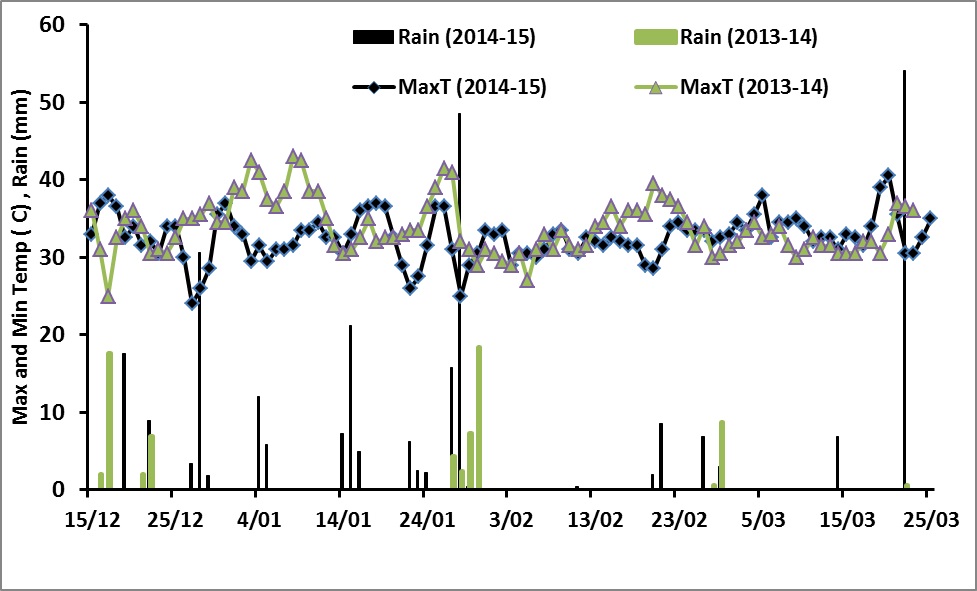
Figure 1. Comparison of 13/14 and 14/15 summers at Warra
In the 2 sites for 13/14 Jade-AU was the highest yielding variety across all row spacing treatments, followed by the other large seeded commercial variety Crystal. The small seeded pre-release variety MO9246 (since released as Celera II) was much quicker to flowering and maturity and prior to harvest a portion had shelled out of the pods, losses were estimated to be as high as 30%, however the stated results are as harvested and not adjusted for loss.
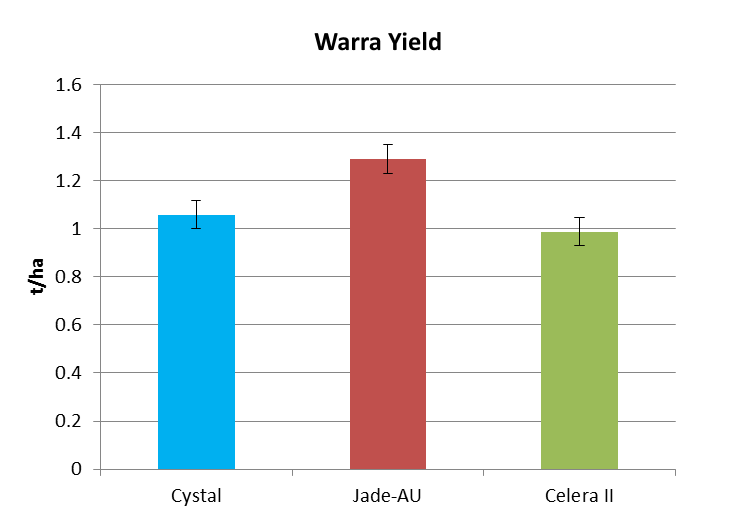

Figure 2. Variety grain yield for all row spacings at Warra (LSD 5% 119.2) and Dalby 13/14 (LSD 5% 101.2)
The highest yields at Warra were in the 25cm row spacing at 1.219 t/ha, although this was not significantly better than the other row spacing treatment, with the lowest of 0.972 t/ha for the 1m treatment.

Figure 3. Warra row spacing yields for all varieties 2013/14 (LSD 5% 258.2)
The highest yield at Dalby in 2013/14 was from the 50cm row spacing treatment, but there was no significant difference between the 25cm and 50cm treatments, however there was a significant difference to 1m row spacing.

Figure 4. Dalby row spacing yields for all varieties 2013/14 (LSD 5% 81.6)
When the Warra row spacing by variety is graphed as in Figure 5, it can be seen that there is no effect of row spacing on the yield of Celera II. There is an effect on Crystal which is significant when row width is increased from 25cm to 50cm with a nearly 300kg/ha yield drop, with a further significant drop out to 1m rows.
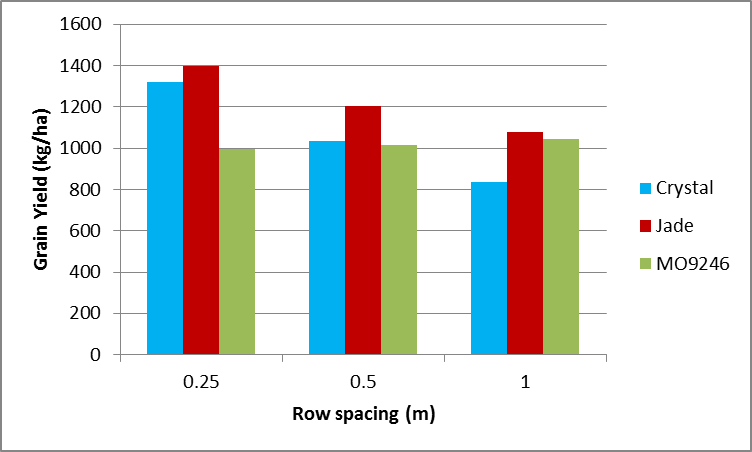
Figure 5. Grain yield of mungbeans at Warra by variety and row spacing treatment (LSD 5% 370)
As the plot size is the same and the plants on different row spacings had access to the same volume of soil the differences in yield are due to the narrower rows being more efficient at converting soil moisture to grain as in Table 2.
Table 2. Water use efficiency (WUE) of row spacing treatments at Warra 2013/14 (LSD 5% 2.3)
|
Row space (m) |
0.25 |
0.5 |
1 |
|
WUE
(kg grain/mm)
|
11.1 |
9.7 |
8.9 |
The 2014/15 results have not been fully analysed at the time of writing however some of the results from the Warra site have been included as a comparison to the much drier season before. In the much better weather conditions of 2014/15 yields were doubled that of the previous season.
The 2014/15 results have confirmed that Jade-AU has performed better than Crystal and 2 pre release lines (discussion limited to the commercial available varieties).
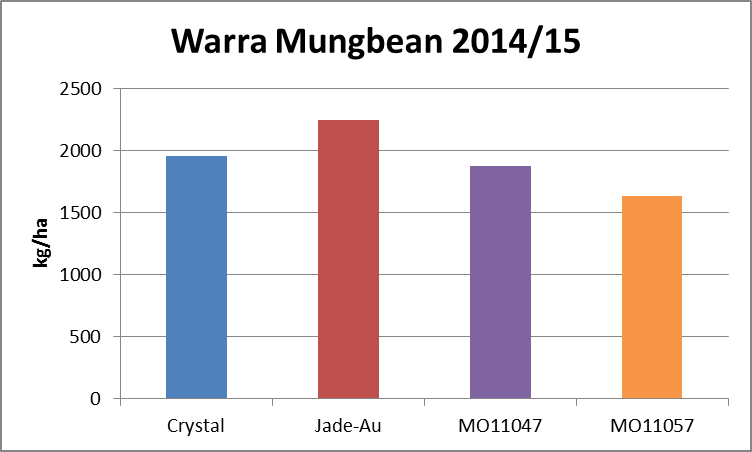
Figure 6. Warra 2014/15 mungbean variety yields, all row spacings (LSD 5% 562)
The yield differences between the varieties were not significant, there is significant difference between 0.25 and 0.5m and the 1m spacing. Crystal was the only variety that had not significant difference across row spacings, the other varieties all had lower grain yields at 1m.
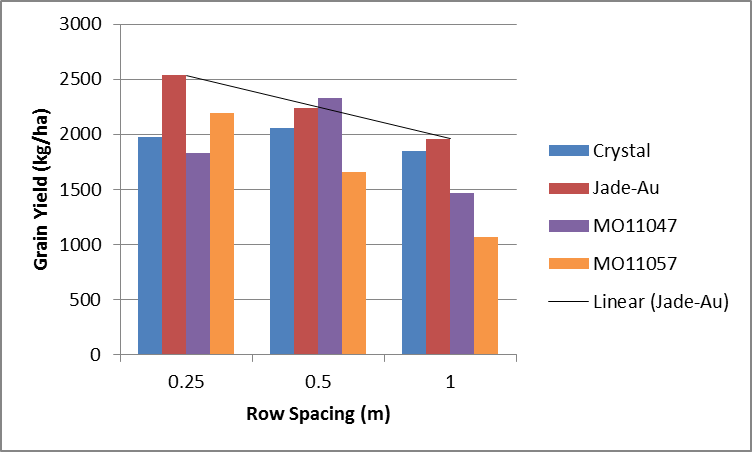
Figure 7. Warra 2014/15 mungbean grain yields variety x row spacing (LSD 5% 704)
In the first year there was no statistical difference in grain yield at the differing plant populations, however there was a trend for lower yields at 10 plants/m2 and a flat yield response in 20, 30 and 40 plants/m2. In the 2014/15 Warra results, which was a much higher yielding season, there appears to be yield increase in line with increases in the population across all varieties (not significant). This may suggest in high yielding environments that the target population should be above the current recommendation of 30 plants/m2.
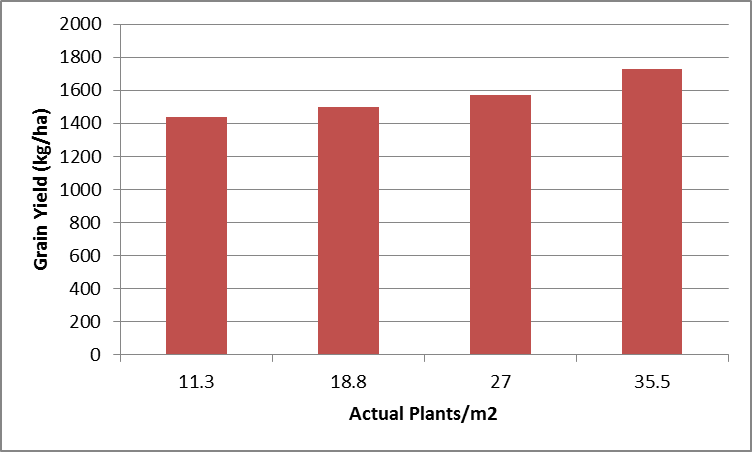
Figure 8. Warra 2014/15 plant population yields (LSD 5% 318)
Mungbean nitrogen fixation
It has been shown that agronomic practices can influence the amount of nitrogen fixed by pulse crops. The 2013/14 mungbean trial at Dalby was sampled for number of nodules per plant, nitrogen in dry matter and grain and the proportion of that nitrogen that was derived from the atmosphere (%Ndfa). The site had an inherently high nitrogen of 150kg/ha and this in conjunction with the low yields at the site limited the amount of nodules to less than 1 per plant when sampled and the %Ndfa figures also showed that the amount of nitrogen in the plant from fixation by rhizobia varied from less than 9% to 16% with no distinct trends due to changes in row spacings.
This is in contrast to previous work at Kingaroy in the 2012/13 season. In this trial differences in the amount of nitrogen fixed was evident between varieties and the row spacings across all varieties (Figure 9).
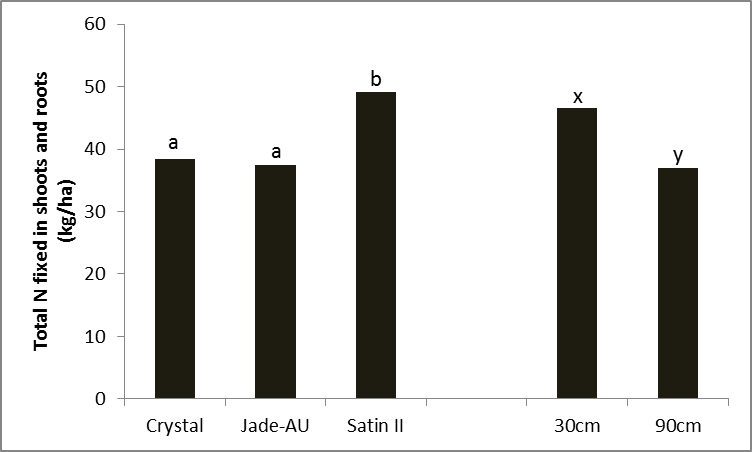
Figure 9. Differences in total shot and root nitrogen by variety (LSD 5% = 7.65) and row spacing (LSD 5% = 6.24), Kingaroy 2012/13
The differences in the amount of N in the shoots and roots (Figure 9) can be influenced by the amount of total dry matter produced or the percent of nitrogen derived from the atmosphere (%Ndfa). It can be seen in Figure 10 that the amount of nitrogen derived from the atmosphere for Crystal and Jade-AU was different with changes in row spacings, however Satin II kept the amount of N from the atmosphere constant at the varying row spacings.
As we have shown with the other trial results narrower rows are producing higher yields which must be supported by higher dry matter production. The crop then has a higher nitrogen demand that is being met by an increase in the nitrogen fixed by rhizobia and provided to the plant.
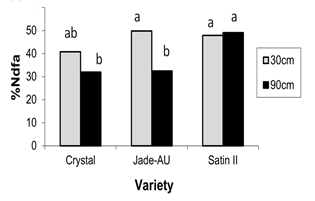
Figure 10. %Ndfa of different varieties at 2 row spacings, Kingaroy 2012/13 (LSD 5% = 9.28)
Summary and conclusions
Mungbean yields can be improved by planting at narrower row spacings. This has been evident in both a below average and above average seasons. The reasons are not fully understood but are suspected to relate to root morphology and how they explore the soil volume for water and also the larger crop canopy on narrow row spacings intercepting more of the light energy and reducing soil evaporation.
Populations are not as important in determining yields and the current industries recommendations should remain as the target populations. The fact that lower populations are not reducing yields significantly may help in making replanting decisions when establishment is affected by other factors.
Both of these factors, row spacing and population, and their effect on maximising yields in varied climates, along with improved varieties, will lead to greater confidence in the ability to grow a profitable crop. This will ensure mungbeans are a viable cropping option in the farming enterprise and not just a break crop for the cereal dominated systems.
Acknowledgements
The research undertaken as part of this project is made possible by the significant contributions of growers through both trial cooperation and the support of the GRDC, the author would like to thank them for their continued support.
The Queensland Pulse Agronomy group would also like to extend their appreciation to the trial co-operators who have hosted our trials.
Contact details
Kerry McKenzie
Department of Agriculture and Fisheries, Queensland
203 Tor St, Toowoomba
Ph: 0477 723 713
Email: kerry.mckenzie@daf.qld.gov.au
Varieties displaying this symbol beside them are protected under the Plant Breeders Rights Act 1994.
GRDC Project Code: UQ00067,
Was this page helpful?
YOUR FEEDBACK
